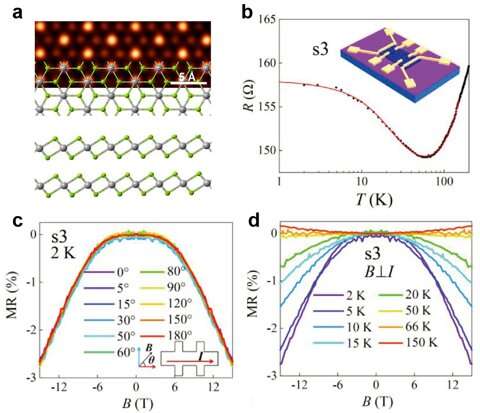Localized magnetic moments induced by atomic vacancies in transition metal dichalcogenide flakes

The emergence of two-dimensional (2-D) materials provides an excellent platform for exploring and modulating exotic physical properties in the 2-D limit, and has driven the development of modern condensed matter physics and nanoelectronic devices. Among various exotic physical properties, 2-D magnetism is one of the most important topics, which shows potential application in spintronics. In recent years, researchers have discovered a series of intrinsic 2-D magnetic materials, such as CrI3, Fe3GeTe2, etc. However, most of the yet discovered 2-D magnetic materials are instable in atmosphere, which limits further investigation and the application of 2-D magnetism. Therefore, the key issue is how to induce magnetism in air-stable 2-D materials.
Recently, Professor Wang Jian at Peking University, in collaboration with Professor Duan Wenhui at Tsinghua University, and Professor Zhang Yanfeng at Peking University, detected localized magnetic moments induced by Pt vacancies in transition metal dichalcogenide PtSe2 flakes, and revealed the origin and flake-thickness dependence of the localized magnetic moments. The paper entitled "Magnetic Moments Induced by Atomic Vacancies in Transition Metal Dichalcogenide Flakes" was published online in Advanced Materials. Professor Wang at Peking University, Professor Duan at Tsinghua University and Professor Zhang at Peking University are the corresponding authors of this paper. Ge Jun, Luo Tianchuang at Peking University, Lin Zuzhang at Tsinghua University, and Shi Jianping at Wuhan University contributed equally to this work (joint first authors).
PtSe2 flakes with thicknesses of 8-70 nm were grown by chemical vapor deposition (CVD), and their high crystalline quality was confirmed by transmission electron microscopy and selected area electron diffraction. The researchers further fabricated PtSe2 devices of different thicknesses and studied their electrical transport properties. The longitudinal resistance decreases with the decrease of temperature in high temperature regime, which is typical metallic behavior. Interestingly, on further decreasing the temperature, the longitudinal resistance increases logarithmically and then tends to saturate at ultralow temperatures.

At low temperatures, isotropic negative magnetoresistance (NMR) is detected when an in-plane magnetic field is applied. Further analysis shows that the logarithmic increase of the longitudinal resistance with the decrease of temperature and the isotropic NMR originate from Kondo effect. The well-known Kondo effect usually arises in a non-magnetic metal doped with magnetic impurities, resulting from the exchange interaction between the spins of conduction electrons of non-magnetic host and magnetic impurities. However, the characterization results have demonstrated that there are no magnetic elements in PtSe2 flakes.
The origin of the localized magnetic moments in PtSe2 flakes is revealed by theoretical calculations. The Pt vacancy defects are inevitable to arise during the growth of the PtSe2 flakes. The Pt vacancies result in an asymmetric distribution of the occupied spin majority and minority states of the p orbitals of the three neighboring selenium atoms, finally giving rise to the localized magnetic moments. Surprisingly, the observed magnetic moments seem to be thickness-dependent. When reducing the thickness of flakes, the localized magnetic moment becomes larger. Theoretically, the local magnetic moment in the sample is mainly contributed by the Pt vacancies on the sample surface. With decreasing thickness of the PtSe2 flake, the surface-to-bulk ratio increases, leading to an increase of relative proportion of surface vacancies. As a result, the averaged magnetic moment induced per defect increases with the decreasing thickness, which is consistent with the experimental observations. This work provides a new route for the modulation of magnetism at the atomic scale in non-magnetic 2-D materials, especially in air-stable 2-D materials, and has potential significance in the development of spintronics and quantum information.
More information: Jun Ge et al. Magnetic Moments Induced by Atomic Vacancies in Transition Metal Dichalcogenide Flakes, Advanced Materials (2020).
Journal information: Advanced Materials
Provided by Peking University




















